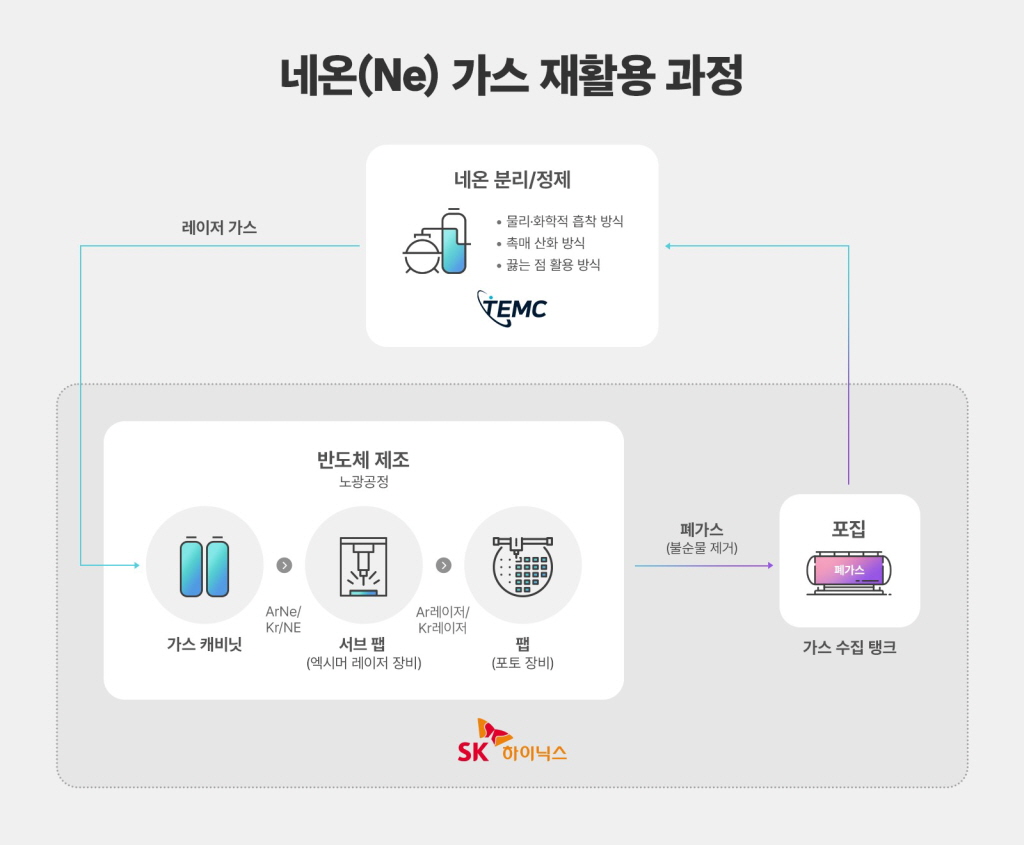SK하이닉스가 네온 재활용 기술에 성공해, 네온 구입에 들어가는 비용과 온실가스 배출량을 줄이고, 네온 수급에 안정을 가져올 것으로 기대된다.

▲네온가스 재활용 과정(자료 : SK하이닉스)
포집 후 불순물 제거, 회수율 77% 목표
온실가스 배출량 1만2천tCO2e/yr 줄여
SK하이닉스가 네온 재활용 기술에 성공해, 네온 구입에 들어가는 비용과 온실가스 배출량을 줄이고, 네온 수급에 안정을 가져올 것으로 기대된다.
SK하이닉스는 TEMC와 협업해 네온(Ne) 가스 재활용 기술을 개발했다고 1일 밝혔다.
재활용 기술 개발에 나서 1년여 만에 거둔 성과다.
네온은 반도체 노광공정에 필수적인 엑시머 레이저 가스(Excimer Laser Gas)의 주요 성분이다.
네온은 레이저 광원으로 활용할 때 화학적으로 분해되거나 변형되지 않는다는 특징이 있어 한 번 사용한 네온은 불순물 제거 등의 분리 및 정제만 거치면 재활용이 가능하다.
SK하이닉스는 이 점에 주목해 노광공정 이후에 스크러버를 통해 공기 중으로 배출되던 네온 가스를 수집 탱크에 포집하고, TEMC의 가스 처리 과정을 통해 네온만 선택적으로 분리해 정제 했다.
이렇게 정제된 네온은 다시 SK하이닉스로 공급돼 반도체 제조 공정에 사용된다.
현재 네온 회수율은 72.7%에 이른다. SK하이닉스는 앞으로 지속적으로 정제수율을 개선해 네온 회수율을 77%까지 높일 계획이다.
네온 재활용 기술이 반도체 팹에 적용될 경우 연간 400억원 상당의 네온 구매 비용이 줄어들 것으로 예상된다.
아울러 이 기술은 네온 생산 과정에서의 온실가스 배출량(Scope 3)을 1만2,000tCO2e/yr 가량 줄이는 효과도 창출할 것으로 보인다.
네온 재활용 기술 개발을 주도한 SK하이닉스 탄소관리위원회의 소재 재활용 분과는 반도체 공정에서 화학적으로 분해 및 변형되지 않는 모든 소재의 재활용을 최종 목표로 삼고 있다.
분과는 2025년까지 네온, 중수소(D2), 수소(H2), 헬륨(He) 등 4개 가스 소재와 황산(H2SO4) 등 화학 소재를 비롯해 총 10개 원자재의 재활용 기술을 개발할 계획이다.
2030년까지는 화학적 변형이 없는 모든 소재에 대한 기술 검토를 완료한다는 것이 회사의 목표다.
